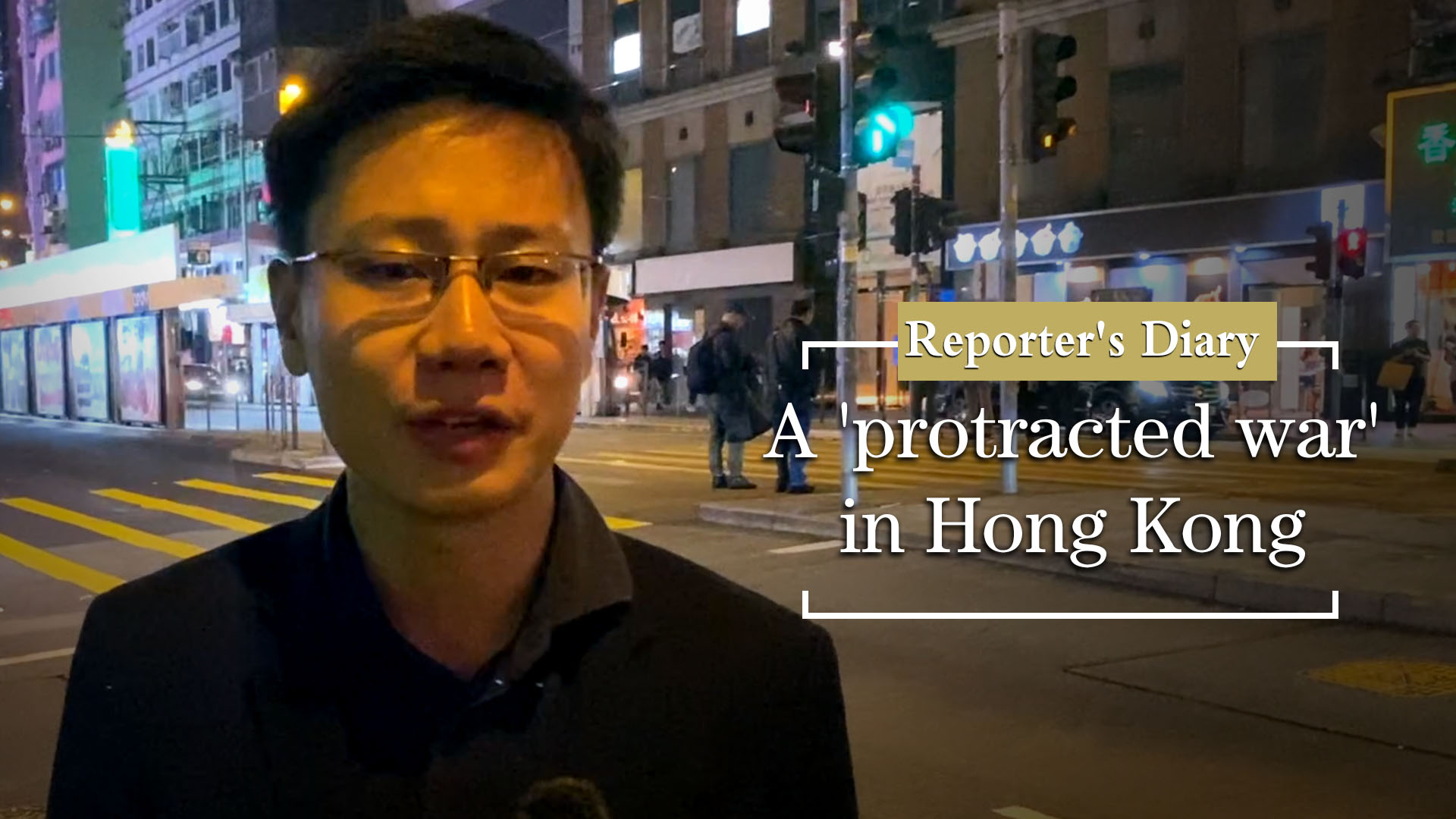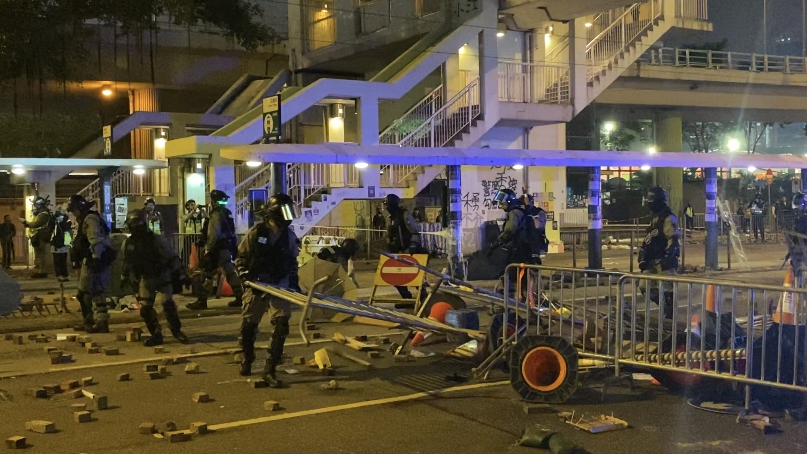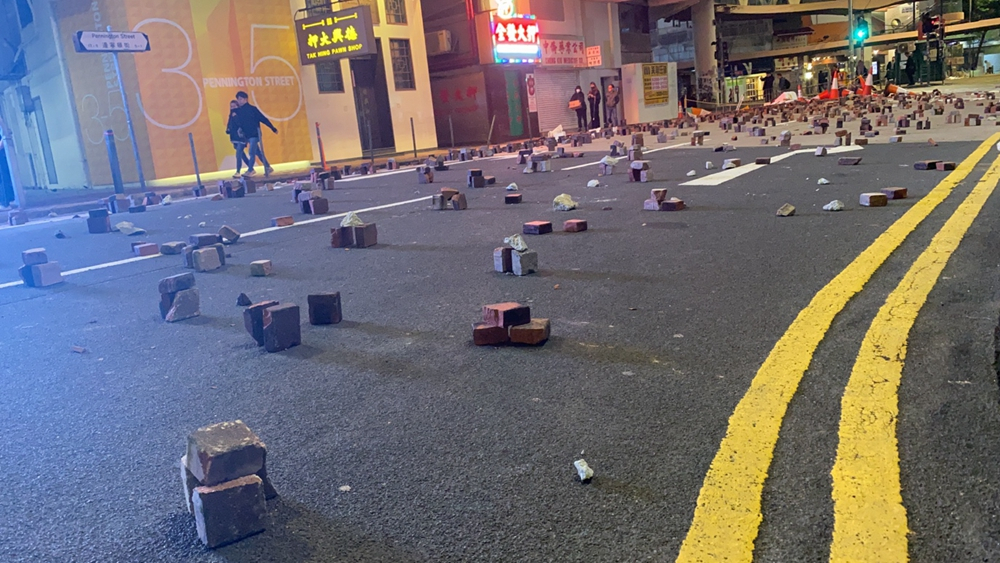01:34

The unrest in Hong Kong has continued into 2020, a new decade. On the very first day of the new year, a massive anti-government protest took place on the streets. Unfortunately, violence and vandalism were seen, despite the promise from the event's organizer Civil Human Rights Front that the protest would be peaceful.
Vandalism found its way into some shops and banks, including Pacific Coffee, Starbucks and several branches of the HSBC. The iconic lion sculptures – nicknamed as Stephen and Stitt – outside HSBC's headquarters office building in Central were sprayed with red paint.
"We strongly condemn the acts of vandalism and damage directed at our premises," said a statement issued by HSBC.
Petrol bombs were thrown, and makeshift road barricades were built by protesters to block the traffic on New Year's Day. Bricks dug up from the pavement and arranged in threes were used to block the roads.

Riot police remove road barricades improvised by radical protesters. / CGTN Photo
Riot police remove road barricades improvised by radical protesters. / CGTN Photo
To disperse the crowds, the riot police – nearly 3,000 of them on the first day of 2020 – resorted to pepper spray, tear gas and water cannons. Subsequently, 287 people were arrested for illegal rallies, and some of them were accused of attacking the police.
Civil Human Rights Front expressed their resentment of the measures employed by the riot police, arguing that they were "targeting the peaceful protesters as a scare tactic to keep people from joining demonstrations."
The police department responded in a statement. "No one has the privilege to take part in a riot when the police officers have given repeated warnings for people to leave," refuted Senior Superintendent Ng Lok-chun. "You can claim to be a first-aider, a human rights observer, you name it. But this doesn't give you any exemption from the legal liability from taking part in a riot."
'Five demands, not one less'
Clad in black with masks on, the protesters marched on slowly, chanting in unison the slogan "Five demands, not one less." The protesters have been requesting independent inquiry into police actions, amnesty for all arrested and universal suffrage.
Various gestures by the protesters, indicating a variety of meanings, including "turning back," "it's safe," and "needs more supplies," were also used during the protest. Despite the huge crowds, a lane in the middle of the road is always spared to transport supplies, including road railings and umbrellas, to the "frontline."

Bricks dug up from pavements are placed on streets to block the traffic in Hong Kong. / CGTN Photo
Bricks dug up from pavements are placed on streets to block the traffic in Hong Kong. / CGTN Photo
The Causeway Bay area, a hot shopping spot in Hong Kong, was fraught with graffiti, reading "Five demands, not one less," "Glorify Hong Kong once again" and rancorous curses in the local dialect.
"The unrest has a big impact on my life. I used to hang out at night, but now I'm always worried if the subway is closed, or if the radical protesters would disrupt public order," said a Hong Kong resident.
"I'm not afraid. I've been working here since the 1980s. Hong Kong has changed, and I don't like to see this," said a foreign expat from the Philippines.
Hong Kong has been troubled by the unrest for the past seven months. But the city's resilience and efficiency can be demonstrated in how fast the public facilities are repaired, thanks to the hard work and effort by maintenance workers.
Traffic lights vandalized are back in operation the next day, and roadblocks are cleared away the next morning. People can still go about with their ordinary lives until the next protest, which usually happens on weekends.
What does 2020 hold for Hong Kong, and how long will the protracted protests last? Only time can tell, but many in the city are becoming impatient.